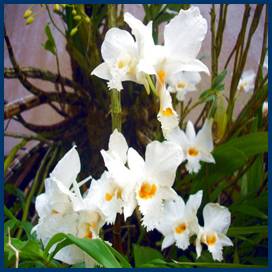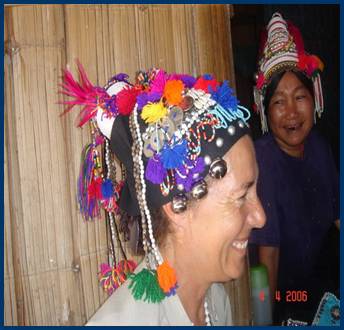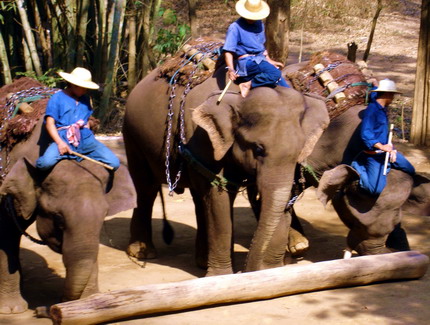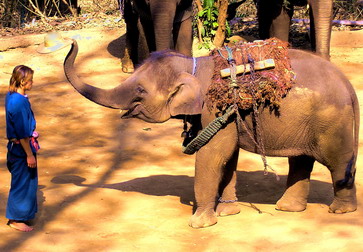|
1ST
April 2006
Having
decided to have a part-time home in THAILAND, it was
a good opportunity to discover the Northern Highlands of this ancient Kingdom
in more depth with our French friends, George and Claude, with whom we had
visited Vietnam in 2004.
|
|

|

|
|
CHIANGMAI used to be the ancient capital of Thailand, and it shows with its
prosperous temples and buildings in the city centre, fed by a circular canal
system around the city’s ramparts. The sprawling suburbs are the
evidence of how busy this city is, and the surrounding countryside the reason
why so many people love to visit this area, so close to the cool mountains
and lush farmlands of this rapidly developing country.
 
|
|
  
|
|
These
cockroaches must be a tasty dish for some! Maybe if you have your eyes
closed it would taste like a crunchy prawn? The Prime Minister
Thaksin’s Party flyers were everywhere, the election was next day,
which in fact was null and void as the opposition did not turn up! Most
people in the countryside voted for him as he has given grants to many
farmers and business start up funds which has boosted their earning
potential. It’s the intellectuals in the country who cannot abide his
having pocketed (or distributed amongst his family and close allies) the
funds from the sale price of the country’s largest telecom business.
 
Mae Salong
is in the N.E. Highlands, cool enough to grow Oulong tea in its many
varieties. The Chinese have been growing and exporting this crop over two
generations. Rising early to do some tea tasting with all the ceremonial
proceedings was a perfect way to start the day.
|
|
 
These two
temples overlook the village of Mae Salong
and the tea plantations.
 
Buddha’s
statue overlooking the Mekong River, and Naga
serpent adorning temple steps
The Golden
triangle, where Thailand meets Laos and Myanmar (Burma) has a natural barrier
of high mountainous ranges, impossible to police before Thailand had roads
built and better infrastructure to promote the agricultural revolution it has
had over the past decade.
This fertile
land used to be planted with opium poppies, but now there is hardly any sign
of this cultivation. Instead it is chrysanthemums and citrus trees which
seem to be the cash crop, interspersed with coffee and other fruit and nut
trees.
 
To come
across this wonderful Doi Thon orchid garden high up on one of the mountain
tops was almost like walking in dreamland. The Queen of Thailand decided to
promote tourism in this dangerous area by planting acres of woodland with
these exotic flowers, and thereby give jobs to the minority tribal people who
enjoy tending these plants and gardens.

|
|
 
This young girl comes from Phuket and was visiting
her Mum. Striking up in conversation with her, neighbours all came along to
show us their handiwork making the AKA tribal costume.
 
Notice photo of the King in the background,
that’s standard for any home in Thailand, even bamboo ones.
 
This old
lady is selling me a necklace, notice her teeth stained red from chewing
betel nuts!

Border
guards live in these camps. They get around by horse to the difficult areas
that need policing against illegal immigrants and opium growing

|
|

|
We are
lost, the guards help us out with their wonderful survey maps, which we
wish we had!
|
 
More borders
guards pose for us, not a bad place for them to have lunch?
The burnt
hillsides are evidence of the undergrowth which is burnt off this time of
year, not so good for the young fir trees, but it does no harm to the teak
trees, the main cash crop in the rain forest area lower down the slopes.
 
Rice Paddies
in the valleys, and onions drying in these huge sheds waft their aroma
through the air.
 
Topiary
gracing the entrance to the agricultural research station. The lovely little
girl is adorning the Elephant training camp

|
Ooh
– what fun the elephant’s having spraying his keeper at bath
time!

Do these
elephants have pleasure in working like this? I’m not so sure

But this
young chap is happy to remove his keeper’s hat!


With so
much teak around growing on the hill behind the of Lek guest house where we
stayed, it is a tribute to great craftsmanship. The gate to the house is
very Chinese, which is where most of the population of this town of Lae Hom Song originated from 200 years
ago.

 
Teak
leaves form the roofing material for these houses, very hard wearing and
effective too!
|
|
|

